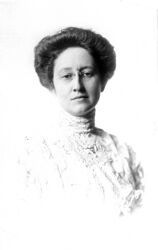
Beta chapter becomes the first chapter to move from a dormitory hall to a fraternity lodge.

Epsilon chapter is established at the University of Southern California. It is the first West Coast chapter.

Zeta chapter is established at the New England Conservatory. This was the only chapter of the Fraternity not at a college or university.

Mary Janet Wilson (Alpha, DePauw University) becomes the first alumna to be elected president of the Fraternity. She serves from 1896-98.

Records show this as the "6th" convention, even though it was only the fourth large gathering, with 24 attendees. Musical call was adopted, Alpha (DePauw University) chapter was made permanent Grand Chapter and the first request was made that convention items be submitted ahead of time and dispensed to delegates before coming to convention.

Alpha (DePauw University) chapter hosted 25 attendees for the second time. The request for a secret motto was given to Beta (Albion College) chapter, The Lyre was made a quarterly publication and the design of the final badge was requested.

The Fraternity was first governed by Alpha (DePauw University) chapter (1885-91) and then by general officers elected from the chapters in rotation. At the 1898 National Convention, the present form of government, then called the Grand Council and now called the National Council, was established with officers elected at each biennial national convention.

Raeburn Cowger Obenchain (Alpha, DePauw University) serves as the first Grand President from 1898-1902.

The Spanish-American War begins as the U.S. intervenes on the side of Cuba in the Cuban War of Independence. When the war ends, the United States temporarily controls Cuba and owns Puerto Rico, Guam and the Philippine islands. The Philippines will not gain independence until 1946. Puerto Rico and Guam remain U.S. possessions to this day.

Eta chapter is established at Bucknell University.

Theta chapter is established at the University of Michigan.

36 attendees came to Albion College to make decisions that have long withstood the test of time. Conventions would be held every two years, Grand Council would be the governing body of the Fraternity and the future of alumna membership would be prioritized.

Iota chapter is established at the University of Illinois at Urbana-Champaign.

The diamond-shaped pledge pin is adopted at the 1900 National Convention. Previous to this, new members had simply worn scarlet and olive green ribbons.

A woman's place was considered to be "in the home." One in four states denied a married woman the right to own property. One in three did not allow her to claim her own earnings, and 36 states (of 45) denied her an equal share in the guardianship of her own children.

Zeta (New England Conservatory) chapter brought 29 attendees to the East Coast by horse and carriage. Robes were added to the Ritual, The Heraeum was introduced and the pledge pin was adopted.

Kate Calkins Lovejoy (Beta, Albion College) serves as Grand President from 1902-07.

Gamma (Northwestern University) chapter hosted 34 attendees, including the entire Grand Council. The closing night banquet saw an additional 41 members attend. At this convention, the office of historian was created, exam questions of pledges were adopted and active members were given an annual exam on the constitution and vital matters, with results posted in The Lyre.

Alpha Chi Omega attends a meeting of the Intersorority Conference, later renamed the National Panhellenic Conference, for the first time in 1903, a year after the organization's founding.

Generally, women still make their clothes from McCall or Butterick patterns, but mass-produced garments begin to come onto the market. Women spend $14 million on corsets alone!